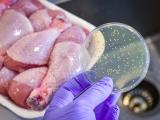Jun 19, 2008 (CIDRAP News) – The number of patients sickened in a Salmonella outbreak linked to tomatoes has grown by 106 more cases, a sign that states have ramped up their surveillance in response to the event, federal food safety officials said at news conference yesterday.
The total number of patients infected with an unusual strain, Salmonella enterica serotype Saintpaul, now stands at 383, with six more states and the District of Columbia now reporting cases, raising the total number of states that have been affected to 30, according to an update yesterday from the US Centers for Disease Control and Prevention (CDC).
Robert Tauxe, deputy director of the CDC's division of foodborne, bacterial, and mycotic diseases, told reporters that the spike in outbreak cases doesn't necessarily represent an uptick in the number of newly diagnosed patients. Rather, he said it appears states are catching up on receiving and reporting their laboratory results confirming the strain.
The most recent group of lab confirmations suggests that the most recent illness onset date was still Jun 5, the same as the CDC's Jun 16 update. "We have to say the outbreak is ongoing at this time, but it's too early to call the peak," Tauxe said.
At least 48 hospitalized
Based on interviews with 243 people, at least 48 people were hospitalized, according to the CDC. Though no deaths have officially been linked to the outbreak, a Texas man in his 60s who died of cancer was infected with the outbreak strain, which may have contributed to his death, the agency has said.
David Acheson, associate director of food for the Food and Drug Administration (FDA), said the trace-back investigation is progressing, though officials haven't determined the source of the contaminated tomatoes. The FDA has said it is focusing on growing regions in south Florida and certain parts of Mexico—two areas that were harvesting and distributing tomatoes to the US market when the Salmonella Saintpaul infections were first reported.
At another media briefing today on the outbreak, Acheson said officials from Mexico and Florida are continuing to work with the FDA on the outbreak investigation, and he backed down from his statement yesterday that he believed Mexican officials had identified some Salmonella Saintpaul cases that may or may not have matched the outbreak strain.
Inspectors have not found the outbreak strain in any tomato samples, he said.
Difficulties with trace-back
Authorities are still hopeful that the recent identification of a nine-person case cluster will yield some clues about the source of the tomatoes, Acheson said. Though the FDA cannot share any details about the retail outlet or location involved in the cluster, officials from the Chicago Department of Public Health said yesterday that nine of 17 local residents who were sickened by the outbreak strain had eaten at Adobo Grill, which has two area locations, the Associated Press reported.
Acheson said trace-back investigations involving contaminated tomatoes are notoriously difficult. "When you think you're getting close, all of a sudden the investigation takes a different direction," he said, adding that tomatoes are a very common food and that people who are interviewed for epidemiological studies often have difficulty remembering where they bought or ate tomatoes or what type of tomatoes they consumed.
"We're hopeful that as we learn more, there may be a cluster in other states. We're still going flat out, but we're not quite there yet," Acheson said.
China-US food statement
In other food safety developments, the US Department of Health and Human Services (HHS) announced yesterday that US and Chinese officials signed a progress statement on steps taken by both nations to implement a 2007 memorandum of agreement between the two countries on food and feed safety.
Representatives of the United States and China are in economic dialogue talks this week in Annapolis, Md., HHS said in a press release yesterday.
In December 2007, the United States and China signed a food safety pact that was prompted by a series of recent tainted-import incidents, including chemically contaminated pet food and seafood containing unauthorized drugs. The agreement was designed to ease the flow of information between the two countries and allow US officials better access to Chinese food processors.
According to HHS, the United States and China have made progress in several areas, including:
- Establishing a mechanism for cooperating on major food and feed safety events
- Starting work on a system that will allow Chinese authorities to electronically certify products that meet FDA standards
- Agreeing on a training program on US regulatory standards for Chinese officials
- Vowing to inform each other about significant health risks or consumer concerns
See also:
Jun 18 CDC press release
Jun 16 CIDRAP News story "Case cluster found in Salmonella outbreak"
Jun 18 HHS press release
Dec 11, 2007, CIDRAP New story "US, China report pact to make food imports safer"
















